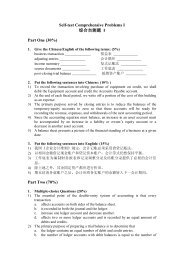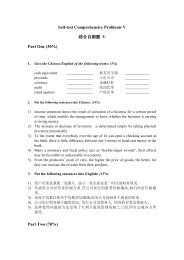Vodafone Group Plc Annual Report for the year ended 31 March 2012
Vodafone Group Plc Annual Report for the year ended 31 March 2012
Vodafone Group Plc Annual Report for the year ended 31 March 2012
Create successful ePaper yourself
Turn your PDF publications into a flip-book with our unique Google optimized e-Paper software.
<strong>Vodafone</strong> <strong>Group</strong> <strong>Plc</strong><br />
<strong>Annual</strong> <strong>Report</strong> <strong>2012</strong><br />
16<br />
Chief Executive’s review (continued)<br />
“We have continued to<br />
stimulate data adoption by<br />
encouraging customers to<br />
upgrade to smartphones,<br />
and offering a broad portfolio<br />
of <strong>the</strong>se handsets across<br />
a range of price points.”<br />
Our strategic priorities:<br />
aa<br />
Mobile data<br />
aa<br />
Emerging markets<br />
aa<br />
Enterprise and total<br />
communications<br />
aa<br />
New services<br />
Priorities<br />
All <strong>the</strong> elements of our <strong>Group</strong> strategy are<br />
covered in detail elsewhere in <strong>the</strong> annual<br />
report. In this section, <strong>the</strong>re<strong>for</strong>e, I think it is<br />
more useful to give you some deeper insight<br />
into what I see as <strong>the</strong> key priorities <strong>for</strong> <strong>the</strong><br />
business over <strong>the</strong> <strong>year</strong> ahead, and where<br />
<strong>Vodafone</strong>’s leadership team will be focusing<br />
<strong>the</strong>ir energies. Some of <strong>the</strong>se priorities<br />
are, indeed, specific constituents of our<br />
strategy; o<strong>the</strong>rs reflect our ability to influence<br />
<strong>the</strong> markets in which we operate or <strong>the</strong><br />
resources we have at our disposal to execute<br />
our strategy.<br />
Data<br />
After many <strong>year</strong>s of investment and<br />
technological development, <strong>the</strong> customer<br />
experience of mobile data services in<br />
developed markets has now generally<br />
reached very good levels, with <strong>for</strong> example,<br />
high quality streamed video now widely<br />
available. However, operators in Europe have<br />
three significant challenges when it comes to<br />
data services: pricing, commercial costs and<br />
customer usage.<br />
Our progress on pricing is inconsistent. In <strong>the</strong><br />
best markets we are successfully generating<br />
incremental ARPU of €10 a month as we<br />
migrate customers to smartphones and data<br />
packages. However, in o<strong>the</strong>rs <strong>the</strong> uplift is<br />
more marginal, often driven by <strong>the</strong> level of<br />
competition in <strong>the</strong> market. Our goal over <strong>the</strong><br />
next 12 months is to achieve a more consistent<br />
revenue return from data – through faster,<br />
more reliable networks, significantly enhanced<br />
customer service, and a range of new and<br />
differentiated services accessible through<br />
<strong>the</strong> handset.<br />
Un<strong>for</strong>tunately, almost all of <strong>the</strong> incremental<br />
ARPU we are generating ends up being<br />
invested in commercial costs. The smartphone<br />
market is still skewed to <strong>the</strong> high end, which<br />
has driven significant increases in average<br />
customers acquisition and retention costs over<br />
recent <strong>year</strong>s. Looking ahead, we see scope <strong>for</strong><br />
more competition in <strong>the</strong> handset market as<br />
new vendors seek to enter <strong>the</strong> market and<br />
more established players look to grow in <strong>the</strong><br />
mid-tier. This should drive down our customer<br />
investment costs.<br />
The pressure on our top line, particularly in<br />
Europe, is intense and we need to protect<br />
profitability through better cost discipline.<br />
Commercial costs are <strong>the</strong> biggest single<br />
cost in our business and we will not<br />
successfully stabilise margins unless we<br />
manage <strong>the</strong>se acquisition and retention costs<br />
more rigorously.<br />
Finally, we need to find a way to stimulate<br />
customer consumption of data. Average data<br />
usage on a smartphone in Europe is around<br />
a third of that in <strong>the</strong> US and less than a fifth<br />
of that in some parts of Asia. We have to work<br />
more effectively at showing customers <strong>the</strong>y<br />
can use data more freely while still controlling<br />
<strong>the</strong>ir spend, and also helping <strong>the</strong>m understand<br />
what <strong>the</strong>y can actually use data services<br />
<strong>for</strong>. The ongoing upgrade to our European<br />
network, creating a plat<strong>for</strong>m which offers<br />
high speed data services everywhere we<br />
provide a voice connection, will in itself breed<br />
additional demand.<br />
Regulation<br />
The telecoms industry continues to<br />
experience intense regulation on mobile<br />
termination rates (‘MTRs’), and voice and<br />
data roaming. In addition, auctions of new<br />
spectrum are often structured to favour new<br />
entrants at low prices. The consequence of<br />
<strong>the</strong>se actions is to suppress investment in next<br />
generation mobile and fixed networks, and<br />
thus to limit our ability to provide high speed<br />
data across a broad footprint. This universal<br />
access to high speed connectivity is a key<br />
goal of regulators across Europe, and will not<br />
be achieved if <strong>the</strong> current onerous level of<br />
regulation continues. I see it as a major priority<br />
to continue to work with my industry peers<br />
and local and EU regulators to find a fairer<br />
balance which protects customers while<br />
encouraging investment and competition.<br />
I have been very vocal in my objection to this<br />
ongoing regulation, much of which has not<br />
produced <strong>the</strong> results int<strong>ended</strong> by regulators.<br />
For example, reductions in mobile termination<br />
rates since 2009 have not meant that prices<br />
fall faster <strong>for</strong> mobile consumers and have not<br />
encouraged fixed line customers to make<br />
more calls to mobiles. If anything, <strong>the</strong> opposite<br />
has happened. I believe regulators should<br />
avoid auto pilot regulation that does not check<br />
whe<strong>the</strong>r regulation has achieved its purpose.’<br />
Customer experience<br />
Our retail stores around <strong>the</strong> world<br />
are being reconfigured to ensure<br />
customers leave <strong>the</strong> store with <strong>the</strong>ir<br />
smartphone ready to use with technical<br />
experts available to resolve customers’<br />
questions and device problems. By May<br />
<strong>2012</strong> 4,400 of our stores provided <strong>the</strong>se<br />
services and during this <strong>year</strong> we will<br />
fur<strong>the</strong>r expand <strong>the</strong> roll out.<br />
More detail<br />
Page 25






